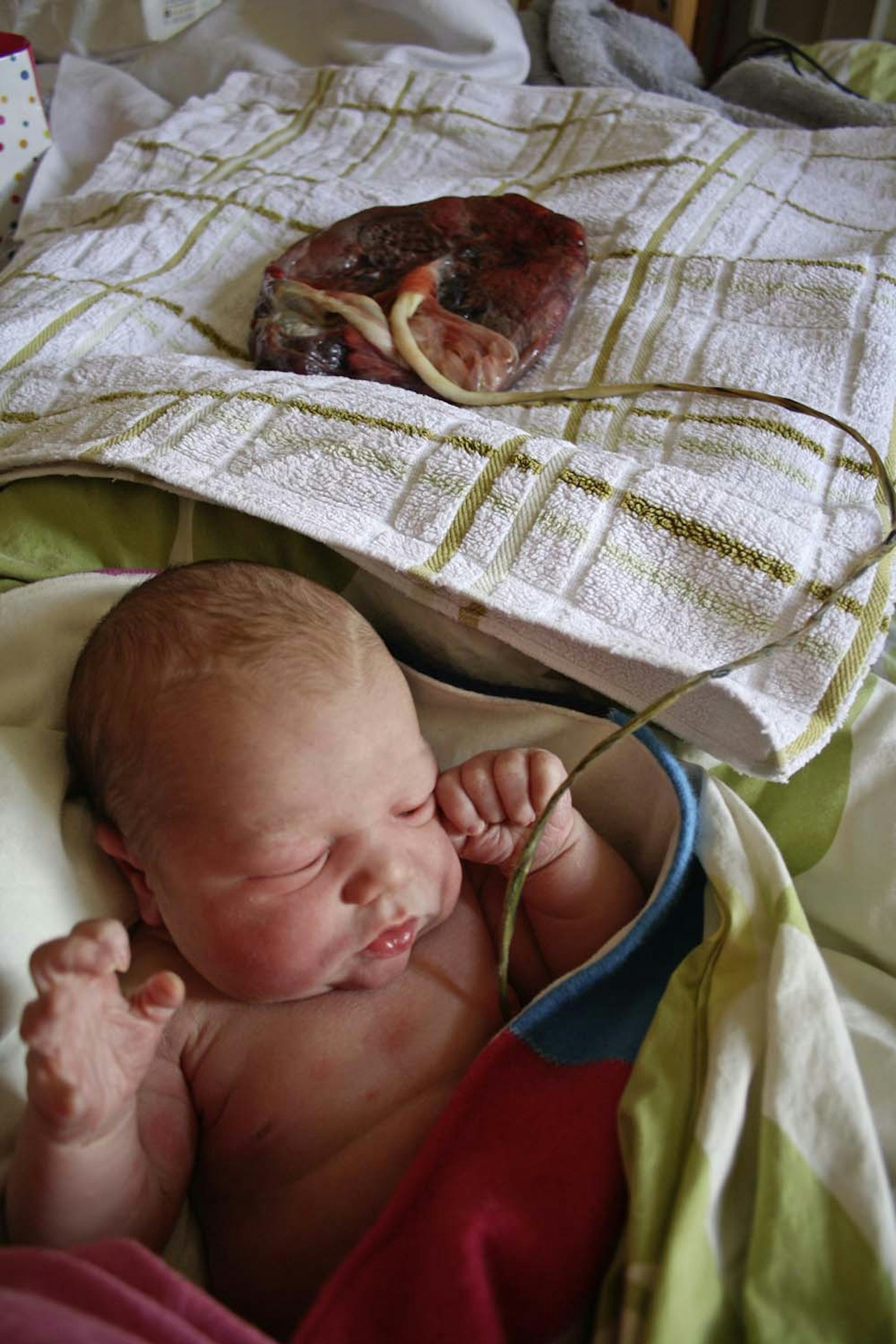If you've never heard of a lotus birth - don't worry, you're not alone! We dive into exactly what a lotus birth is and why you might want one as well as sharing one mum's experience of her lotus birth.
What is a lotus birth?
A lotus birth is when a mother births her baby and placenta but chooses to leave the cord uncut so the two are attached until the cord falls off on its own. This is in contrast to the conventional practice of cutting the umbilical cord to detach baby from the placenta which usually occurs a few minutes after the baby is born.
"The cord vessels clamp shut after they have stopped pulsating and then slowly dries to a hard, twig-like consistency. Separation usually occurs from around 3 days after the birth. This obviously creates the dilemma that there is a large organ attached by the cord to the baby that will be decomposing," explains Lesley Gilchrist, Registered Midwife and Co-Founder of My Expert Midwife.
Spiritual meaning of a Lotus birth
According to herbal-training.com, a lotus birth holds spiritual meaning for people. "Lotus Birthing is a sacred ceremony. The family likely values the transition between womb and mother. The family may also respect the connection the baby has with the placenta. Baby did just spend 9 months with it."

Lotus birth benefits
Although there is no evidence to back these up, benefits of a lotus birth are believed to include the following:
• Your baby will receive increased blood and nourishment from the placenta.
• It is believed that a lotus birth is a more gentle, less-invasive transition for the baby into the world.
• A spiritual ritual which honours the relationship between the baby and placenta.
"Whilst most people may think this idea is a little crazy and wonder why you would go to such lengths, those who have had a lotus birth, report that their babies have an easier and calmer transition from intrauterine life to the outside world," says Lesley.
"Having a lotus birth certainly has the potential to prevent the baby from being moved and passed around a lot during the early days after birth. This could encourage mother and baby bonding and help to establish breastfeeding, by limiting mother and baby separation time."
Risks of a lotus birth
• There is limited research on lotus births so this may make you feel uncomfortable about trying it.
• Can increase the risk of infection.
• The umbilical cord may accidentally get ripped away from the baby's body.
How can I ask for a lotus birth?
"You can request a lotus birth at your local hospital by discussing this with the midwife or medical team who care for you during your labour. You can also write your wishes into your birth plan," explains Lesley. "Make sure everyone involved in your birth knows not to clamp and cut the cord after your baby has been born and that you want a lotus birth."
"There may be instances where a lotus birth is not recommended and it can depend on the type of birth you have. If you have a birth where heavy bleeding is involved then your medical team may want to clamp and cut the cord and remove the placenta quickly to help prevent further haemorrhaging. In the unlikely situation that your baby needs immediate resuscitation, the cord may need to be cut to perform this. If your baby needs special care for any reason, doctors may recommend cutting the cord as their unit will need to adhere to more sterile and aseptic guidance," says Lesley.
How do I stop getting an infection from a lotus birth?
"To help prevent infections and offensive odours the placenta is washed twice a day with water, then a blend of herbs and Epsom salts are massaged into it," Lesley explains. "It is then placed into a waterproof bag and then into a cloth bag."
Lotus birth story
Hannah Winbolt-Robertson, 38, a doula trainer, lives in York with her three children Tom, nine, Daisy, seven, and Oren, two. She says:
"In my work as a doula supporting women through labour and birth, I noticed that newborns tend to cry when the umbilical cord is cut, even though it contains no nerve endings.
I read up on the benefits of leaving the cord and placenta to detach naturally in the days after birth, which is called a lotus birth. I learned that babies tend to be quieter and calmer in the first few days if the cord is allowed to separate naturally.
Rather than enter the NHS system, I hired an independent midwife who was comfortable with lotus birth and with my decision to give birth at home with a doula, without a midwife present. I’d done my research, had experience of lots of births and knew my pregnancy was straightforward. If the baby or I were at risk at any point, my plan was to go to the hospital.
My first signs of labour began at 5am when I was 40 weeks and one day. I was woken by a sweeping pressure across my bump and the contractions came every 20 minutes. My then-husband went to work as normal, but my two children were at home with me.
By 10.30am, contractions came every 10 minutes. I listened to music, swaying my hips to relieve the pressure in my stomach. I texted my husband to come home. I messaged my doula, Claire. As a courtesy, I also informed my midwife I was in labour.
I got the children to help fill the birthing pool up. I’d always planned for them to be at the birth, and had prepared them by watching real-life birth clips on YouTube. At 11am, I eased myself into the warm water, which felt incredibly soothing.
At 12.45pm, while I was still in the pool, Claire arrived with her baby. I was so happy to see her. I’d been her doula four months earlier, so we were already very close. Knowing Claire was beside me filled me with confidence. Not being constantly monitored was really liberating.
Half an hour later, I felt a gush and realised that my waters had broken. Still in the pool, I felt a huge pressure and placed my hand down to feel the baby’s head. The sensations were incredibly intense and consuming. I followed my body’s instructions to push and, in one huge contraction, the baby’s head emerged. I waited for the next contraction, focusing on my breathing to ease the pressure."

"Then I felt another overwhelming urge to push, and the baby’s body slid out. Catching him in the water was an amazing experience. Five minutes later, my husband arrived to find me cuddling our new son, Oren, in the water.
A few minutes later, I pushed the placenta out in the water and carefully stood up, placing it in a colander over a bucket to allow it to drain. Out of the pool, I carefully dried it with a towel and left it in the colander next to Oren overnight. The process was easy and felt normal and natural.
After 24 hours I followed a ritualistic embalming method which involved rubbing the placenta with herbs and spices to preserve it until the cord was ready to drop off, and placed it in a velvet bag. Still attached to the placenta, Oren was calm and quiet.
On day three, the cord broke near to the placenta. I left the remaining cord attached to Oren until day seven when it detached close to his belly button. He didn’t even notice and I truly believe he and I benefited from such a natural, gentle start to life."
Things I’d tell my friends
- You won’t know until the birth if keeping the placenta attached is practical for you and your family.
- Even if a lotus birth is not for you, you can still make sure your baby benefits from the full quota of blood from the placenta by asking your midwife to delay cord clamping.
Mervi Jokinen, Practice and Standards Professional Advisor at the Royal College of Midwives, says: ‘It’s the woman’s decision about leaving the cord attached but advice is required to prevent infection developing.’
Meet the expert

Lesley Gilchrist (BSc (Hons) Midwifery Studies, MSc Clinical Research Methods) is a registered midwife, hypnobirthing teacher and co-founder of My Expert Midwife. She began her career as a staff nurse in intensive care before starting her midwifery training in 2001 in Newcastle. Throughout her career, Lesley has worked in large teaching hospitals both on delivery suites and within the community. She is also qualified to undertake the Newborn & Infant Physical Examination (NIPE). Her specialist areas include Preconception & fertility, Birth Recovery, Transition to Parenthood, Baby, Clinical Research.
